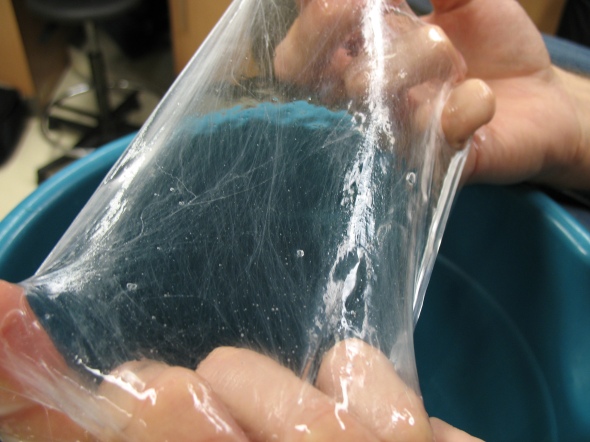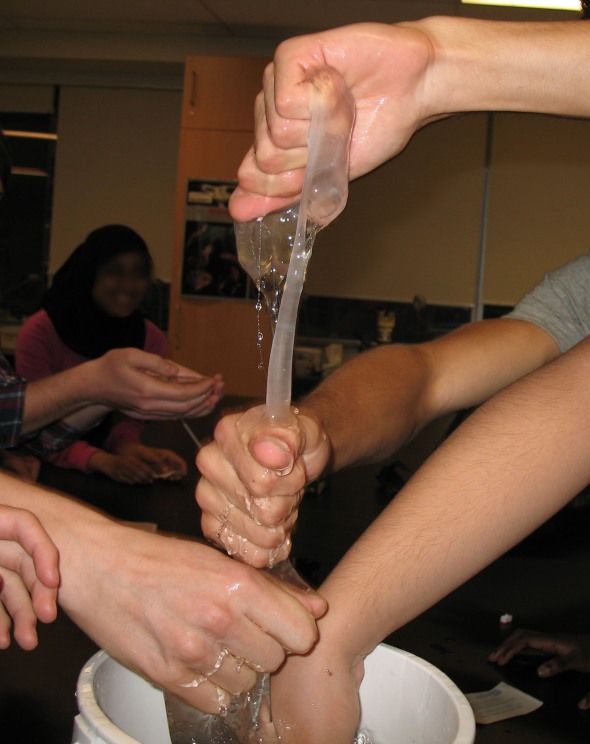Hagfish Slime is the new Spiderweb Silk
Posted: October 29, 2011 Filed under: Biology Research, Biomimicry Methodology | Tags: biodegradable green chemistry, biological models, biomimicry fibres, bridging biology research to design, hagfish slime, high school biomimicry 2 Comments
After only a second or two, these sheets of slime are produced by the small, ancient Hagfish. If you look up close you can see the threads that create a chaotic woven structure that hold the sheets of slime together. Thanks to Jamie Miller for the photo.
This week I helped run a biomimicry workshop with high school kids. Many thanks to Dr Doug Fudge for inviting me in on the session, and Jamie Miller for making it all happen.
During the workshop Dr Fudge showed off his research into whale baleen , and the amazing slime from hagfishes. Jamie and I played with the students, helping them extract functional insights from the organisms and then leading brainstorming sessions around further research questions and design ideas. Overall it was a great experience, biomimicry encouraged everyone to look at the organisms in a different way, and ultimately Dr Fudge was thrown some questions and ideas that he has never considered before, which is always a success.
But the Hagfish Stole the Show

Lovely little critter resting in a neat spiral. Seems like the name hag is a bit harsh, until you get up close to their faces...
Hagfishes live on the bottom of deep, non-tropical waters, and are living fossils, basically unchanged for over 400 million years. Their most startling ability is to produce surprising quantities of slime as a defence mechanism. This slime is likely very good at clogging up the gills of any predators, and challenges even a dextrous human to scoop them out of a small bucket.
What makes the slime amazing are the structural fibres that bind the mucus sheet. Here is a description lifted off Dr Fudge’s research overview:
The slime is composed of fine protein slime threads as well as a mucus component that comes packaged in tiny vesicles. When these components are ejected from the slime glands, they combine synergistically to form a slime mass in which a large volume of water is entrained. Recent work by Julia Herr has investigated the chemical composotion of the slime and the mechanisms of mucin vesicle stabilization an deployment. Tim Winegard recently published a paper on the mechanisms of thread skein deployment, which involves the unravelling of 15 cm long threads from subcellular structures…
These “slime threads” are similar to spider silk in their dimensions, but they differ in a couple of important ways that make them excellent candidates for such a biomimetic project. Slime threads are built within cells from intermediate filament proteins via a process of hierarchical self-assembly. This is quite different from the dynamic spinning process that transforms liquid crystalline spider silk proteins in the silk gland into an insoluble fibre.
To find out more about their research, their publications listing is available here.

You can see the bundles of fibres and how structural the slime gets the more you play with it. Thanks to Jamie Miller for the photo.
The amazing electron microscopy image below shows the tightly bundled cells that unravel into the strands that bind the slime together. These threads can spool off when water runs over them.

One theory suggests that as the hagfish creates these cells the fibres are wound tightly creating potential energy that is somehow released under the right circumstances. Absolutely fascinating.
Here’s a youtube video showing the slime production.
Biomimicry This?
From a biomimicry perspective Dr Fudge and his research team are focusing on replicating the thread fibres. The experiments sound amazing and a little beyond my science scope, but in essence they are looking for the recipe of a self assembling thread that exhibits all the same properties. Their research sounds very positive as the threads are much less complex than spider silk and therefore discoveries are flowing rapidly. I’ll keep you posted as I learn more.
But what about the slime?
The fibres are a no-brainer. Most of our current fibres are made using fossil fuels, and have issues in regards to biodegradability, so finding a replacement for this is critical and potentially very profitable. On the other hand, the slime is just plain weird. When running the biomimicry brainstorming sessions with the students, Jamie and I really encouraged them to think creatively about what the slime is, and what it could inspire.
What is the opposite of a lubricant?

An image of the whiteboard after our brainstorming session. Yes condom is on there, one teenage high schooler one some "cool" points for suggesting that one to his peers. Hmm... slime condom anyone?
Trying to define functionally what the slime does is really challenging and requires some mental callisthenics. On one hand the slime “slows down” liquid, trapping it within the slimy sheets therefore suffocating a gill breathing fish, but then on the other hand it decreases friction, hence the sliminess, making it impossible to grab the little fish. Then there are the weird mechanical properties; the slime is able to hold together structurally, and when agitated binds together further. And lastly, the most intriguing and yet arguably difficult to comprehend is the “volumizing” properties (not sure that is a real word, but we wen’t with it).
Ideas that the students generated include;
- skin grafting bandages, staying damp and not causing a problem as wounds heal
- lubricants for artificial muscles in robotics – there were some pretty sci fi ideas bouncing around
- insulation – expanding when exposed to the environment
- a new kind of filter that traps different liquids

[…] but accessible innovations that are commercially available. They’re not thrilling like silk from a hagfish, but they are real, which is very […]
Thank you for the sensible critique. Me & my cousin were just preparing to do some research on this. We got a book from our local library but I think I learned better from this post. I’m very glad to see such great info being shared freely out there…